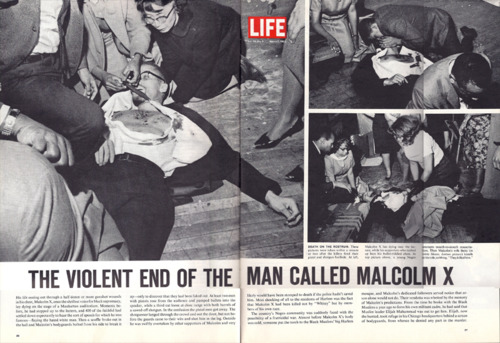
Malcolm X being held by Yuri Kochiyama, supposedly being given cpr by undercover police infiltrator Gene Roberts and viewed by wife Betty Shabazz., a photo by Pan-African News Wire File Photos on Flickr.
By Henry Hagins on February 19, 2014
With raw courage on one hand, and a comrade’s love in the other, she rushed onto the stage, literally, before the gun smoke had cleared, and cradled the head of “Our Shining Black Prince,” as he lay dying at the Audubon Ballroom, that fateful Sunday afternoon of Feb. 21, 1965. Urgently, she pleaded with her comrade and friend Malcolm X not to die, as she tried to comfort him. This heroic gesture was captured in the photo that appeared in Life magazine and once in the hardcover edition of Malcolm’s autobiography.
The oppressive state had finally succeeded in carrying out its cowardly plan, beyond contempt, that had been years in the making. A body of work out there underscores the fact that this “executive action” was government created.
Never a headline grabber, Yuri Nakahara Kochiyama has spent more than 50 years in the trenches, fighting on the illustrious side of human decency and liberation. These roots run deep and include fraternal connections to Workers World Party. And I’m sure editor Deirdre Griswold can share some awesome anecdotes about this with today’s cadre.
It is important to note that Yuri Kochiyama is of Japanese ancestry. She was born May 19, 1921, sharing a birth anniversary with the venerable Vietnamese revolutionary Ho Chi Minh and with Malcolm X, among notable others. Her numerous admirers always mention this fact with unrestrained pride. And rightly so. She is historically linked to both giants.
During World War II, the anti-Japanese internment laws led to Yuri Kochiama’s family being forced from California to a concentration camp in Hattiesburg, Ala. Child at right is one of many relocated to an internment camp.
During World War II, the anti-Japanese internment laws led to Yuri Kochiama’s family being forced from California to a concentration camp in Hattiesburg, Ala. Child at right is one of many relocated to an internment camp.
Her legendary activism spans a multitude of countries, too numerous to mention here; they include countless progressive movements and remarkable personalities. Folks still sing her praise. She is an exemplary participant in the People’s History.
Some of her signature works include supporting political prisoners like Assata Shakur, now refuged in Cuba; Black Panther Safiya Bukhari; Native leader Leonard Peltier; Lolita Lebron of the Five Puerto Rican Nationalists; David Wong; Herman Ferguson; the NY Panther 21; and, of course, Mumia Abu-Jamal.
During World War II, the anti-Japanese internment laws led to her family being rounded up in California and sent to a concentration camp in Hattiesburg, Ala. This experience further fed her developing political education about “real” life in these United States. Her sympathy and bond with the oppressed was strengthened by her desire to combat the racism and gross unfairness that her family and people faced with internment.
She was well-regarded by the late Amiri Baraka and his family, and she supported the Black Arts Movement back in the 1960s. As quiet as it’s kept, before moving to Harlem, she and her family lived in the same apartment building as jazz pianist and composer Thelonious Monk and his spouse, Nellie Smith Monk.
Yuri Kochiyama’s life is best recorded in two great works: “Passing It On,” an autobiography, and “Heartbeat of Struggle,” by Diane Fujino, both published by the UCLA Asian American Studies Center Press in 2004, and both “must reads.” Yuri Kochiyama, now over 90 and living in California, is more than worthy of prolonged applause. All of us would do well to embrace her outstanding, internationalist example.
No comments:
Post a Comment